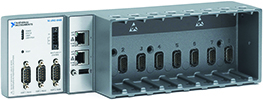Controller Hardware-in-the-Loop testing of a Centralized Scheduler for Microgrid Operations
PhD student Siddhartha Nigam with advisor A. Domínguez-García
Effective operation of microgrids requires a control architecture that implements multiple (and sometimes conflicting) control functions: (1) Frequency control, (2) Voltage control, (3) Optimal asset dispatch, (4) Provision of ancillary services, (5) Optimal power flow, and (6) Synchronization. In my previous work, we have reported on the development and implementation of each of the above control functions in a centralized as well as in a distributed fashion. In addition, we also reported on the important problem of integrating the various different microgrid control functions under the centralized architectural solution. To that end, we previously presented a systematic approach towards building a centralized scheduler for integration and operation of the different microgrid control functions ensuring smooth microgrid operations and transitions during different control objectives. We now provide a few preliminary results obtained as part of the controller hardware-in-the-loop (C-HIL) testing of the centralized scheduler as it drives a microgrid network through three operational objectives. For the testing purposes, we make use of the National Instruments’ (NI’s) Compact RIO (cRIO) 9068 (see Fig. 1) to implement and test the scheduler for coordinating the control functions. For the test system, we make use of a realistic power distribution network operated as a microgrid known as the Banshee microgrid system which was modeled on four Typhoon HIL real time emulators.
We test the scheduler’s capability to drive the Banshee system through two operational objectives: frequency-regulation service provision, and intentional islanding. We carry out a four-minute test with the first sixty seconds dedicated to the microturbine (MT) 1 and 2 synchronization to the Banshee network. At the 65 s mark, the scheduler receives the provision of frequency-regulation command. As part of this objective, we show in Figure 24 how the distributed energy resources increase their generation to reduce the net injection by the bulk grid into the Banshee system at the point of common coupling (PCC) by 2 MW in the next 100 seconds. At the 185 s mark, the scheduler receives the intentional islanding command for feeder 1 and 3 of the Banshee system. We show how MT 1 and MT 2 increase their generation to track zero reference at PCC. Once the injection from the bulk grid into the Banshee system at PCC nears zero, the scheduler sends the request to the PCC switch to disconnect, thus safely islanding the Banshee system. This research is supported by PSERC and the Grainger Foundation.

